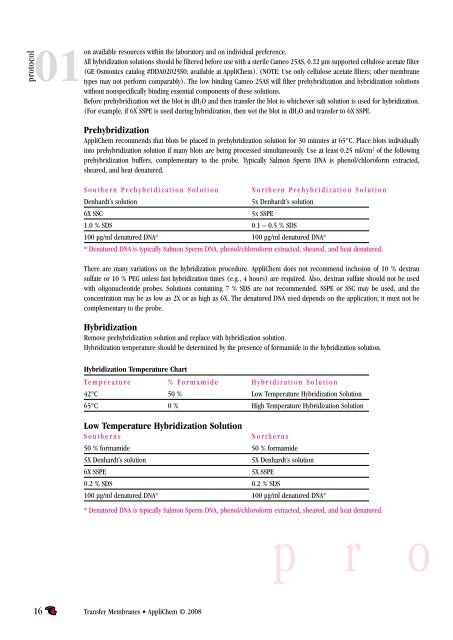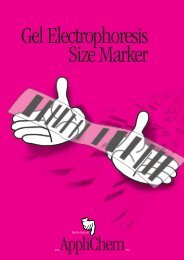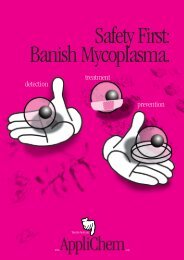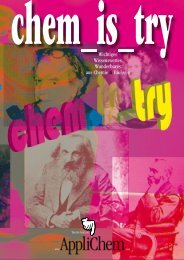Transfer Membranes
Transfer Membranes
Transfer Membranes
You also want an ePaper? Increase the reach of your titles
YUMPU automatically turns print PDFs into web optimized ePapers that Google loves.
protocol<br />
01<br />
on available resources within the laboratory and on individual preference.<br />
All hybridization solutions should be filtered before use with a sterile Cameo 25AS, 0.22 µm supported cellulose acetate filter<br />
(GE Osmonics catalog #DDA02025S0; available at AppliChem). (NOTE: Use only cellulose acetate filters; other membrane<br />
types may not perform comparably). The low binding Cameo 25AS will filter prehybridization and hybridization solutions<br />
without nonspecifically binding essential components of these solutions.<br />
Before prehybridization wet the blot in dH 2O and then transfer the blot to whichever salt solution is used for hybridization.<br />
(For example, if 6X SSPE is used during hybridization, then wet the blot in dH 2O and transfer to 6X SSPE.<br />
Prehybridization<br />
AppliChem recommends that blots be placed in prehybridization solution for 30 minutes at 65°C. Place blots individually<br />
into prehybridization solution if many blots are being processed simultaneously. Use at least 0.25 ml/cm 2 of the following<br />
prehybridization buffers, complementary to the probe. Typically Salmon Sperm DNA is phenol/chloroform extracted,<br />
sheared, and heat denatured.<br />
S o u t h e r n P r e h y b r i d i z a t i o n S o l u t i o n<br />
Denhardt’s solution<br />
6X SSC<br />
N o r t h e r n P r e h y b r i d i z a t i o n S o l u t i o n<br />
5x Denhardt’s solution<br />
5x SSPE<br />
1.0 % SDS 0.1 – 0.5 % SDS<br />
100 µg/ml denatured DNA* 00 µg/ml denatured DNA*<br />
* Denatured DNA is typically Salmon Sperm DNA, phenol/chloroform extracted, sheared, and heat denatured.<br />
There are many variations on the hybridization procedure. AppliChem does not recommend inclusion of 10 % dextran<br />
sulfate or 10 % PEG unless fast hybridization times (e.g., 4 hours) are required. Also, dextran sulfate should not be used<br />
with oligonucleotide probes. Solutions containing 7 % SDS are not recommended. SSPE or SSC may be used, and the<br />
concentration may be as low as 2X or as high as 6X. The denatured DNA used depends on the application; it must not be<br />
complementary to the probe.<br />
Hybridization<br />
Remove prehybridization solution and replace with hybridization solution.<br />
Hybridization temperature should be determined by the presence of formamide in the hybridization solution.<br />
Hybridization Temperature Chart<br />
Te m p e r a t u r e % F o r m a m i d e H y b r i d i z a t i o n S o l u t i o n<br />
42°C 50 % Low Temperature Hybridization Solution<br />
65°C 0 % High Temperature Hybridization Solution<br />
Low Temperature Hybridization Solution<br />
S o u t h e r n s<br />
N o r t h e r n s<br />
50 % formamide 50 % formamide<br />
5X Denhardt’s solution<br />
5X Denhardt’s solution<br />
6X SSPE<br />
5X SSPE<br />
0.2 % SDS 0.2 % SDS<br />
100 µg/ml denatured DNA* 00 µg/ml denatured DNA*<br />
* Denatured DNA is typically Salmon Sperm DNA, phenol/chloroform extracted, sheared, and heat denatured.<br />
p r o<br />
16 <strong>Transfer</strong> <strong>Membranes</strong> • AppliChem © 2008





